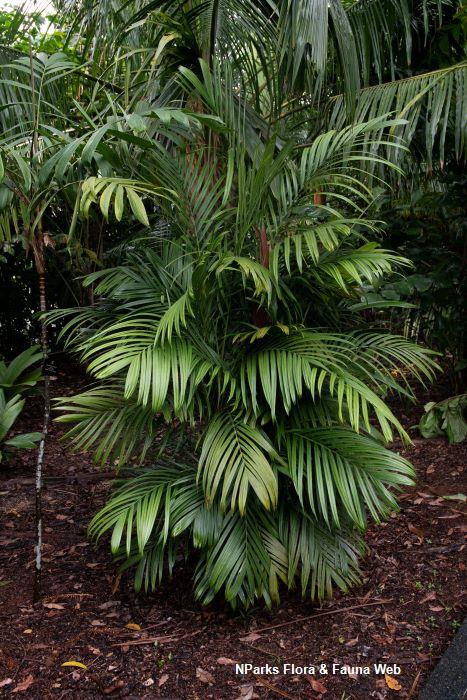
Back
Calyptrocalyx polyphyllus Becc.
| Family Name: | Arecaceae (Palmae) |
| Common Name: | Giagiau, Apolop, Pirare, Peliah, Belin Eddi |
Calyptrocalyx polyphyllus, also known as Giagiau, is an ornamental palm with clustering habit. The young leaves emerge red and gradually turn green as they mature. The leaflet is narrowly lanceolate and tapers towards the tip, forming a prominent filamentous drip tip.
Name
Classifications and Characteristics
| Plant Division | Angiosperms (Flowering Seed Plants) |
|---|---|
| Plant Growth Form | Palm |
| Lifespan (in Singapore) | Perennial |
| Mode of Nutrition | Autotrophic |
| Plant Shape | Irregular |
| Maximum Height | 4 m |
Biogeography
| Native Distribution | Papua New Guinea |
|---|---|
| Native Habitat | Terrestrial |
| Preferred Climate Zone | Tropical |
| Local Conservation Status | Non-native |
Description and Ethnobotany
| Growth Form | It is a clustering palm, up to 4 m tall, with 2 – 5 stems and 7 – 10 leaves on its crown. |
|---|---|
| Foliage | The leaf is green, feather shaped (pinnate), about 60 – 100 cm long with 10 – 21 pairs of leaflets which are evenly spaced. Each leaflet is broadly sigmoid or narrowly lanceolate (about 40 – 45 cm long and 14 – 18 mm wide) which tapers towards the tip forming a prominent filamentous drip tip. The leaf stalk (petiole) is 2 – 12 cm long and shallowed channelled on the upper surface. The young leaf emerges red and gradually turn green. |
| Flowers | The inflorescence is solitary (single spiked), 75 – 100 cm long and occurs between the leaves (interfoliar). Both male and female flowers occur on the same plant (monoecious). However, the male flowers mature first and are completely shed before the female flowers mature (protandrous). Both male and female flowers are white and small (about 5 mm wide). Male flower has 10 – 16 stamens and said to have an odour, while female flower has 3 – 9 tooth-like staminodes. |
| Fruit | Fruit is oval shaped (about 0.9 – 1.1 cm long and 0.6 cm wide) with a beak. It ripens scarlet red and contains one seed within. The seed is oval-shaped (about 0.8 cm long and 0.5 cm wide) with ruminate endosperm. |
| Taxonomy | The type specimen of this species was destroyed during World War II when the Berlin Herbarium was burnt. |
| Cultivation | It can be propagated by seed. |
| Etymology | The genus is Greek for a veil and calyx, with reference to the hooded appearance of the bracts that subtend the flowers in the type species, C. spicatus. The species epithet means elegant. The specific epithet, in Greek, means many leaves, referring to the numerous pinnae or leaflets of the leaf. |
| Ethnobotanical Uses | Cultural / Religious: In Papua New Guinea, the local villages used the stems to make spears. |
Landscaping Features
| Desirable Plant Features | Ornamental Foliage |
|---|---|
| Landscape Uses | Small Gardens |
Plant Care and Propagation
| Light Preference | Semi-Shade |
|---|---|
| Water Preference | Moderate Water |
| Plant Growth Rate | Moderate to Slow |
| Rootzone Tolerance | Well-Drained Soils |
Foliar
| Foliage Retention | Evergreen |
|---|---|
| Mature Foliage Colour(s) | Green |
| Prominent Young Flush Colour(s) | Red |
| Foliar Shape(s) |
Non - Foliar and Storage
| Trunk Type (Palm) | Clustering Habit |
|---|
References
| References | Dowe, J.L. & Ferrero, M.D. (2001). Revision of Calyptrocalyx and the New Guinea species of Linospadix (Linospadicinae: Arecoideae: Arecaceae). Blumea 46(2): 207–251. |
|---|
Image Repository
Others
| Master ID | 33241 |
|---|---|
| Species ID | 7655 |
| Flora Disclaimer | The information in this website has been compiled from reliable sources, such as reference works on medicinal plants. It is not a substitute for medical advice or treatment and NParks does not purport to provide any medical advice. Readers should always consult his/her physician before using or consuming a plant for medicinal purposes. |

_lowres.jpg)
_lowres.jpg)
_lowres.jpg)

_lowres.jpg)